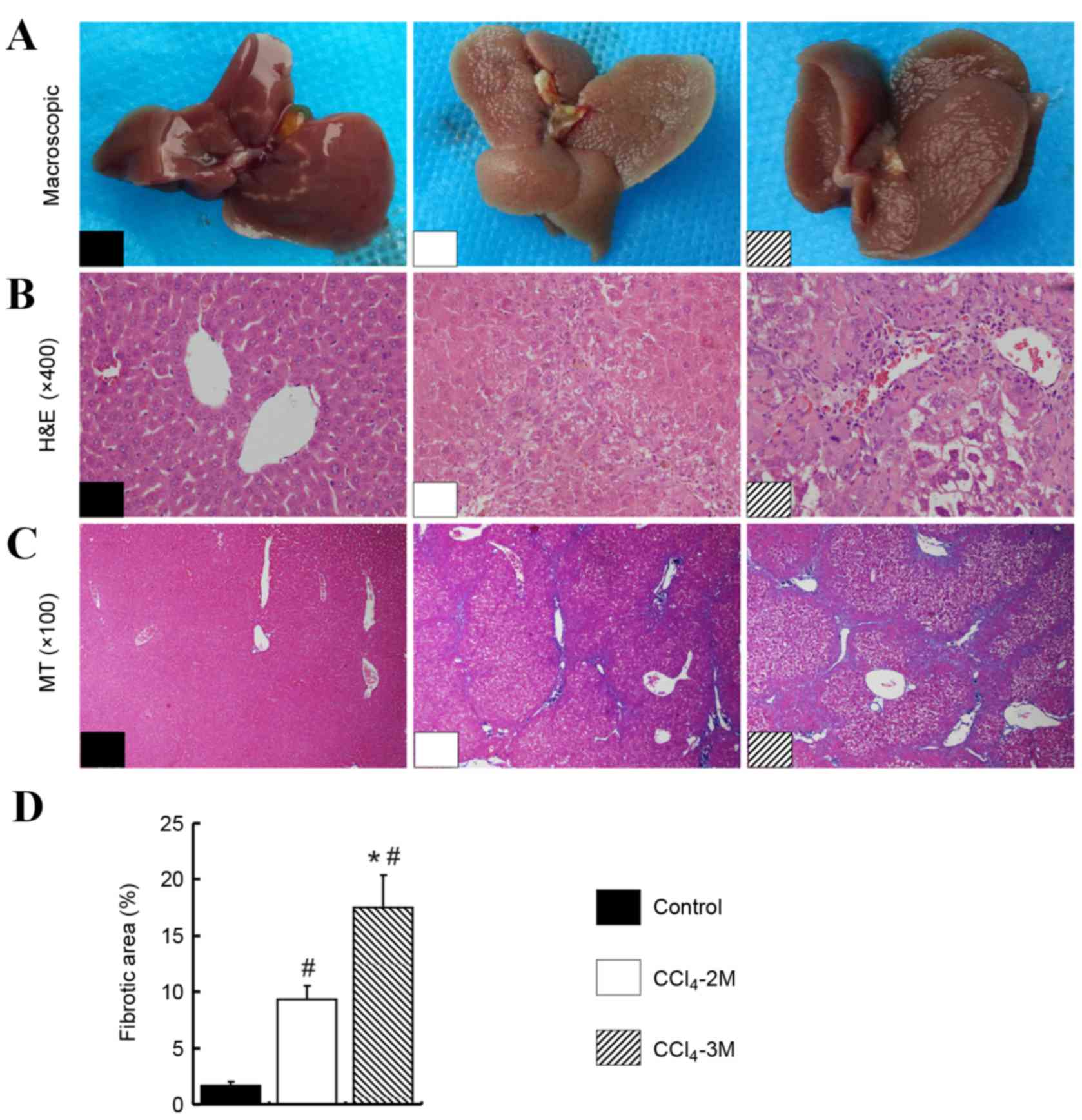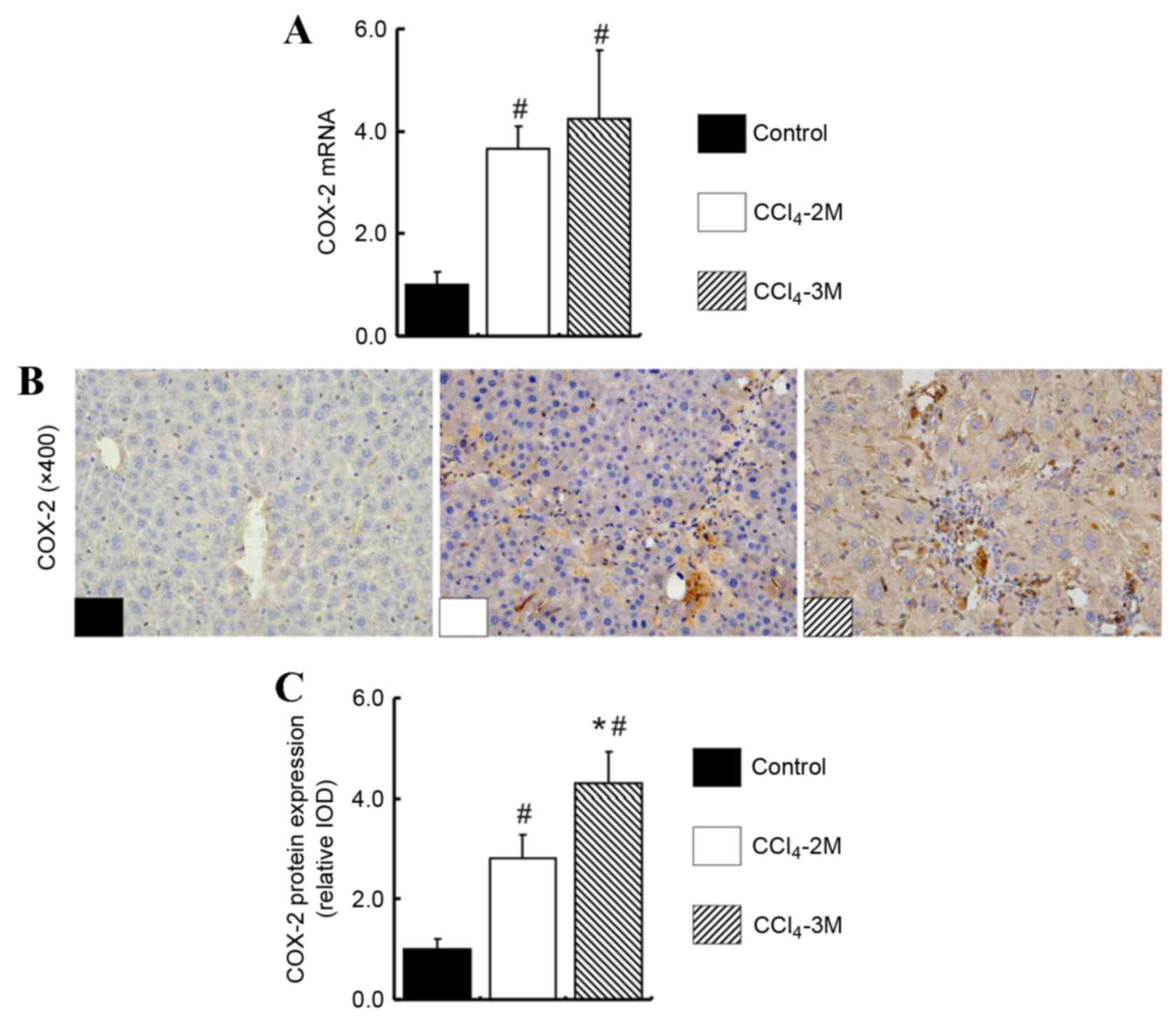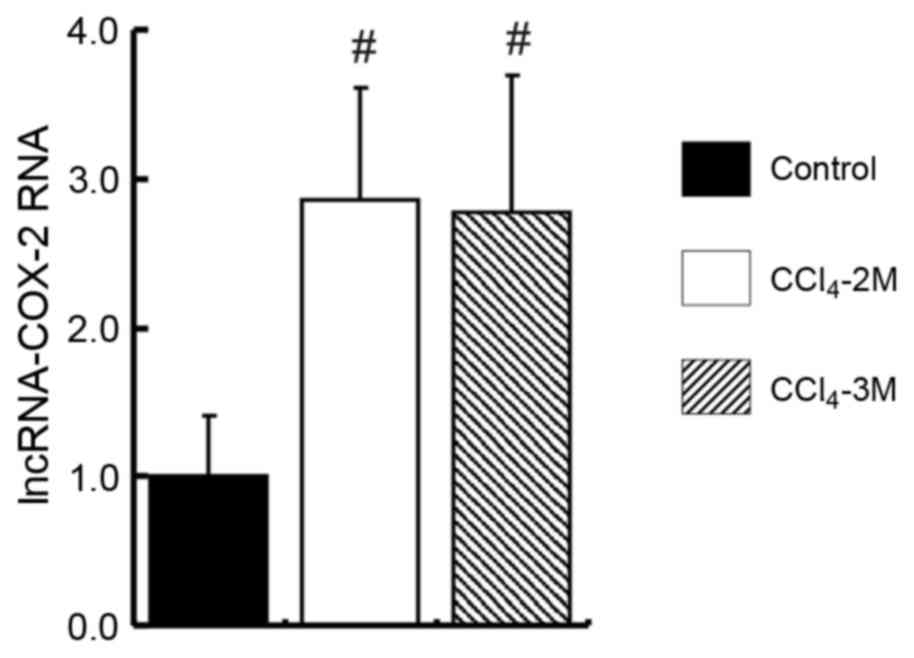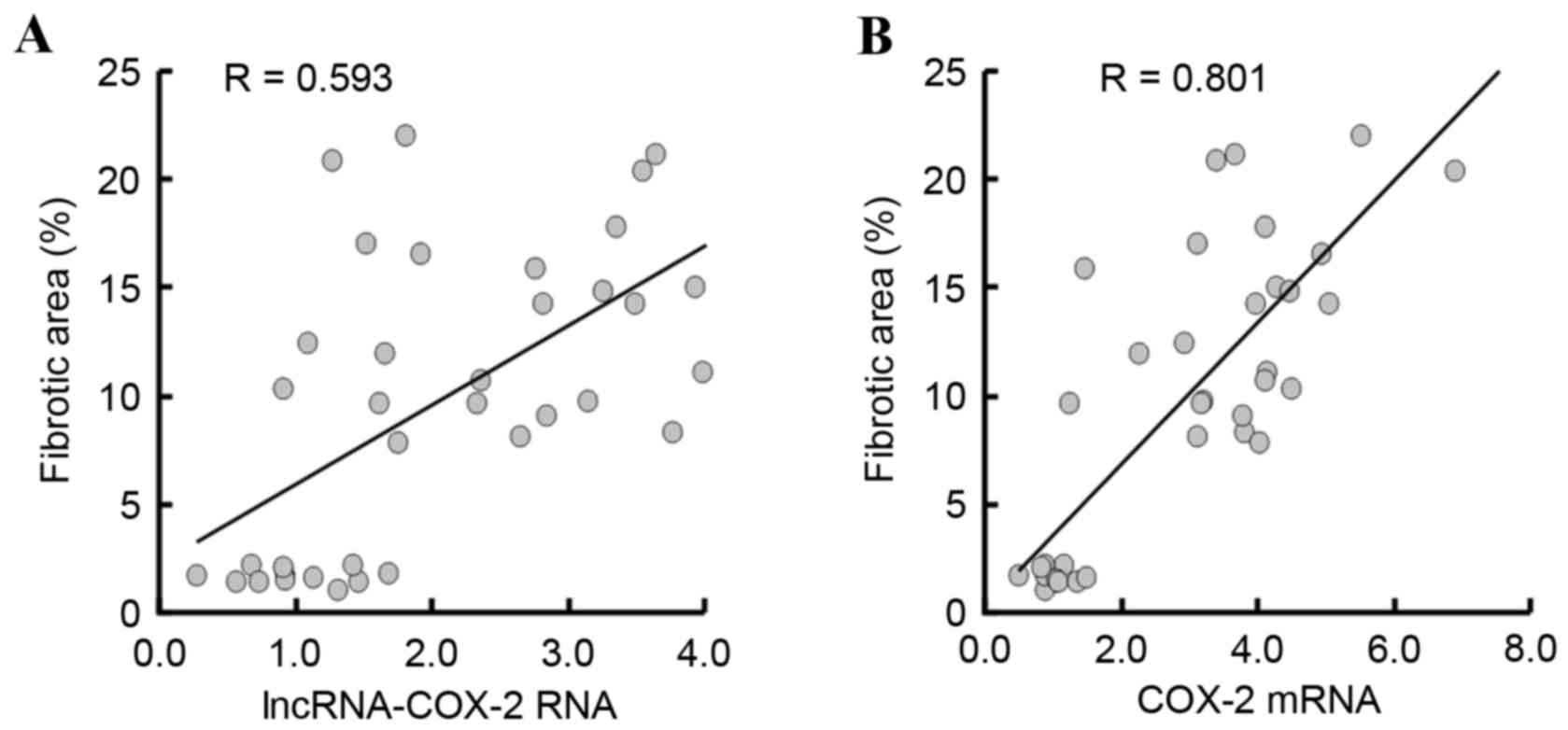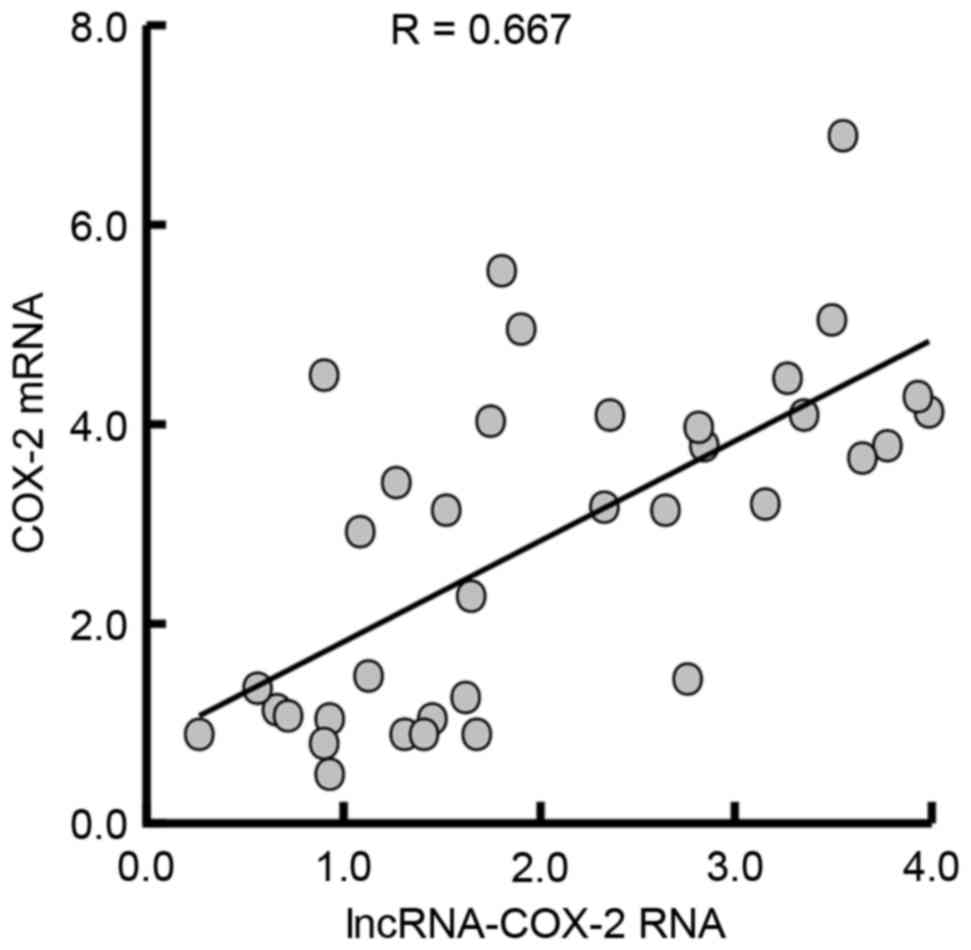Expression of cyclooxygenase-2 is correlated with lncRNA-COX-2 in cirrhotic mice induced by carbon tetrachloride
- Authors:
- Published online on: February 2, 2017 https://doi.org/10.3892/mmr.2017.6161
- Pages: 1507-1512
-
Copyright: © Tang et al. This is an open access article distributed under the terms of Creative Commons Attribution License.
Abstract
Introduction
Liver fibrosis is a result of chronic or sustained liver injury, which may be attributed to viral infections, alcohol abuse, drugs, autoimmune reactions and other causes (1,2). The severe and life-threatening complications of liver fibrosis have made it a global challenge (3). However, limited agents are available to treat liver fibrosis, and liver transplantation remains the only effective therapy, particularly for end-stage liver disease (4).
Cyclooxygenase (COX) is the rate-limiting enzyme in the biosynthesis of prostaglandins and thromboxanes (5). There are two major types of COXs: COX-1 and COX-2. COX-1 is constitutively expressed in multiple tissues, while COX-2 is inducible by a variety of stimuli. Previous studies have reported the upregulation of COX-2 in cirrhotic livers, which indicates that COX-2 may be involved in the process of liver cirrhosis (6,7). However, the involvement of COX-2 in the progression of liver fibrosis is controversial. It has previously been demonstrated that long term administration of a COX-2 inhibitor, celecoxib, efficiently ameliorated liver cirrhosis via dual inhibitive effects on the intrahepatic angiogenesis and epithelial-to-mesenchymal transition of hepatocytes (8,9). However, other previous studies have observed that celecoxib failed to prevent liver fibrosis (10,11). These conflicting results may be due to the dosage of drugs, the experimental duration, and the differential induction of COX-2 according to the site and kinetics of the liver injury (12). Therefore, it is necessary to further investigate the involvement of COX-2 in the liver fibrosis.
Long non-coding RNAs (lncRNAs) are generally defined as endogenous RNA molecules without protein-coding potential, ranging from 200 bp to 100 kbp in length (13,14). Additionally, lncRNAs are involved in regulating gene expression, including chromatin remodeling, transcription and post-transcriptional processes (15,16). An increasing amount of research demonstrates that lncRNAs are involved in liver diseases, particularly in liver carcinomas (17,18). LncRNA-COX-2, which originates close to the COX-2 gene and does not code for COX-2 protein, has been observed to regulate the transcription of inflammatory genes in intestinal epithelial cells (19). Carpenter et al (20) demonstrated that lncRNA-COX-2 may act as a regulatory component of certain specific immune genes that further mediate inflammatory signaling. Furthermore, previous studies have also demonstrated that lncRNAs affect the activation of hepatic stellate cells (HSCs) and liver fibrogenesis (21,22). However, the involvement of lncRNA-COX-2 in liver fibrogenesis remains to be elucidated.
The present study aimed to investigate the expression of COX-2 and lncRNA-COX-2 in a carbon tetrachloride (CCl4)-induced cirrhotic mouse model. Correlations between COX-2 expression, lncRNA-COX-2 expression and liver fibrosis were also determined.
Materials and methods
Animals and experimental groups
Specific pathogen-free male BALB/c mice (n=36; age, 8 weeks; weight, 22–25 g) were obtained from the West China Experimental Animal Center, Sichuan University (Chengdu, China). Mice were housed under 12-h light/dark cycles in an environmentally controlled room (22–24°C, 50% humidity) with access to food and water ad libitum. Liver fibrosis was induced by intraperitoneal injection of CCl4 (4 ml/kg; dissolved in olive oil, 1:1) twice weekly. The mice were randomly divided into 3 groups (n=12 per group) as follows: i) Control group received an injection of normal saline (100 µl, twice a week); ii) the CCl4-2M group received intraperitoneal injections of CCl4 for 2 months; and iii) the CCl4-3M group received intraperitoneal injections of CCl4 for 3 months. Mice were anesthetized by intraperitoneal administration of 4% chloral hydrate (1 ml/100 g), and the mice were sacrificed by exsanguination, 72 h following the final CCl4 injection at 8 or 12 weeks, respectively. The livers were rapidly excised and washed with saline. A part of each liver was immediately stored at −80°C and the remainder was immersed in 4% paraformaldehyde solution. All procedures performed in the course of the present study were approved by the Animal Use and Care Committee of Sichuan University and were conducted according to the regulations of Sichuan University.
Histopathological evaluation
Liver tissues were fixed in 4% paraformaldehyde and embedded in paraffin, cut into 4-µm thick sections and stained with hematoxylin and eosin (HE) and Masson's trichrome (MT) staining. The morphological changes were examined under a microscope (CX41; Olympus Corporation, Tokyo, Japan) equipped with a digital camera (DP72; Olympus Corporation) and analyzed by Image-Pro Plus 4.0 software (Media Cybernetics, Rockville, MD, USA). A total of 3 images per section (x100 magnification) were captured, in order to calculate the total percentages of the fibrotic areas of each group.
Reverse transcription-quantitative polymerase chain reaction (RT-qPCR) for mRNA expression
Total RNA was isolated from all mice liver tissues using TRIzol reagent (Invitrogen; Thermo Fisher Scientific, Inc., Waltham, MA, USA). The RNA was then reverse transcribed using a first-strand cDNA kit (Fermentas; Thermo Fisher Scientific, Inc.) according to the manufacturer's protocol. The expression of RNA was detected by RT-qPCR. The qRT-PCR was performed using the SsoFast EvaGreen PCR master mix (Bio-Rad Laboratories, Inc., Hercules, CA, USA). Reactions were incubated at 95°C for 5 min, followed by 39 cycles at 95°C for 10 sec and 58°C for 30 sec. All samples were run in triplicate using a CFX96 real-time PCR detection system (Bio-Rad Laboratories, Inc.). The primers were synthesized by TSINGKE (Chengdu, China). The primer sequences are listed as follows: COX-2, forward 5′-GGGTGTGAAGGGAAATAAGG-3′, reverse 5′-TGTGATTTAAGTCCACTCCATG-3′; lncRNA-COX-2, forward 5′-CAAAAGTGGGAAGGAAGGT-3′, reverse 5′-TCCAGGAAGGGAAATATACAT-3′) and β-actin forward 5′-TGACGTTGACATCCGTAAAG-3′ and reverse 5′-GAGGAGCAATGATCTTGATCT-3′. The relative expression levels of the target genes were calculated using the comparative 2-∆∆Cq method (23) and normalized to the expression of β-actin.
Immunohistochemical staining
Liver sections were deparaffinized in xylene for 15 min and sequentially rehydrated in 100, 95 and 90% ethanol solutions. Following washing in phosphate-buffered saline (PBS) for 15 min, the heat-induced antigen retrieval procedure was performed. The sections were incubated with 3% H2O2 for 15 min to quench the endogenous peroxidase. A primary mouse polyclonal COX-2 antibody (1:200; ab15191; Abcam, Cambridge, UK) was added to the sections and incubated overnight at 4°C. Subsequent to rinsing with PBS, slides were incubated with horseradish peroxidase-conjugated secondary antibody kits (SP-9001; ZSGB-BIO, Beijing, China) for 1 h at 37°C. Liver sections were stained with diaminobenzidine and counterstained with hematoxylin. Five random fields were selected from each section to evaluate COX-2 expression. Quantification of positive staining was accomplished by using Image-Pro Plus 4.0 software to score integrated optical density at ×400 magnification under a light microscope (CX41; Olympus Corporation).
Statistical analysis
All data were expressed as the mean ± standard deviation. Statistical significance among three groups was analyzed by one-way analysis of variance followed by the Student-Newman-Keuls test. Pearson correlation coefficients were used to describe the strength of correlation. Statistical analysis was conducted using SPSS 13.0 (SPSS, Inc., Chicago, IL, USA) and P<0.05 was considered to indicate a statistically significant difference.
Results
Accumulation of hepatocyte injury and fibrosis following CCl4 administration
Extensive nodular formation was observed following treatment with CCl4 in the livers of the CCL4-2M and the CCL4-3M groups compared with that in the control group. The most marked changes in color and hardness were observed in the livers of the CCl4-3M group (Fig. 1A). Liver tissues stained with HE revealed mild intrahepatic inflammation and partial destruction of the normal architecture in the CCl4-2M group when compared with that in the control group (Fig. 1B). In addition, increased inflammation and hepatocyte necrosis was observed in the CCl4-3M group, with severe damage to the normal architecture and the formation of septa and nodules (Fig. 1B). MT staining further demonstrated the destruction of hepatic structure and reorganized fibrotic septa in the CCL4-2M and the CCL4-3M groups (Fig. 1C). The mean fibrotic areas of liver tissues in the CCl4-2M group and CCl4-3M group were increased by 4 and 9 times, respectively, compared with the control group (P=0.001 and P=0.001, respectively; Fig. 1D). In addition, mean fibrotic areas of the CCl4-3M group were twice those of the CCl4-2M group (P=0.012; Fig. 1D).
Expression of COX-2 is increased in cirrhotic liver
The expression levels of COX-2 mRNA were increased in the CCl4-2M group and the CCl4-3M group compared with the control group (P=0.001 and P=0.001, respectively; Fig. 2A). Although there was no significant difference in COX-2 mRNA expression levels between the CCl4-2 M group and the CCl4-3M group (P=0.452; Fig. 2A), COX-2 protein expression levels were increased in the CCl4-3M compared with the CCl4-2M group (P=0.042; Fig. 2B and C).
Upregulation of lncRNA-COX-2 is observed in the cirrhotic liver
The RNA levels of lncRNA-COX-2 in the CCl4-2M group and CCl4-3M group were 2 times higher than in the control group (P=0.015 and P=0.008, respectively; Fig. 3). However, there was no significant difference in levels of lncRNA-COX-2 RNA between the CCl4-2 M group and the CCl4-3 M group (P=0.385; Fig. 3).
COX-2 mRNA and lncRNA-COX-2 expression are correlated with fibrosis
By analyzing all the data from the three groups, a significant positive correlation between lncRNA-COX-2 RNA expression and fibrotic area was demonstrated (R=0.593, P=0.001; Fig. 4A). Furthermore, COX-2 mRNA expression was also significantly positively correlated with fibrotic area (R=0.801, P=0.001; Fig. 4B).
Elevation of COX-2 mRNA is associated with increased lncRNA-COX-2 RNA expression
Consistently, by analyzing all the data from the three groups, the expression of COX-2 mRNA was significantly positively correlated with increased lncRNA-COX-2 RNA expression in the cirrhotic liver (R=0.667, P=0.001; Fig. 5).
Discussion
Liver fibrosis is a reversible wound-healing process characterized by excessive accumulation of extracellular matrix components, followed by the distortion of normal liver architecture. Without early intervention, this continuous process progresses into liver cirrhosis, which has a poor prognosis and high mortality (24). Multiple anti-fibrotic treatments have been attempted in the past decades, but at present none have succeeded (2). Thus, it is important to identify a novel therapeutic target or biomarker for this condition. In the present study, the expression of lncRNA-COX-2 RNA and COX-2 mRNA was evaluated in CCL4-induced cirrhotic mice, and COX-2 mRNA and lncRNA-COX-2 RNA expression levels were demonstrated to increase in liver fibrosis. COX-2 and lncRNA-COX-2 may, therefore, be involved in the progression of liver fibrosis.
Previous studies have demonstrated that COX-2 is upregulated in the cirrhotic liver (25,26). The involvement of COX-2 involved in the pathology of liver cirrhosis was also verified in previous studies, including inflammation, activation of hepatic stellate cells, epithelial mesenchymal transition and angiogenesis (9,27,28). Although certain previous research has reported that COX-2 inhibitors exacerbate fibrogenesis, COX-2 inhibitors have also been demonstrated to attenuate liver fibrosis in other studies (8,10,29). Consistent with these latter findings, the present study demonstrated that COX-2 mRNA expression levels increased with progression of liver fibrosis. Furthermore, COX-2 mRNA expression levels were positively correlated with the extent of the fibrotic area, which suggested that COX-2 is involved in the progression of liver cirrhosis (6).
LncRNAs have become a topic of interest with the development of sequencing technology in transpriptome analysis (30). In addition, lncRNAs have been demonstrated to be involved in numerous biological processes, including proliferation, differentiation, and apoptosis (31,32). Multiple lncRNAs have been associated with the development of hepatocellular carcinoma (33,34). However, the involvement of lncRNAs in other liver diseases remains largely unknown. It has been demonstrated in the present study that lncRNA-COX-2 was upregulated in the murine CCl4-induced cirrhotic liver. Furthermore, a significant correlation between lncRNA-COX-2 RNA and the extent of the fibrotic area was revealed, suggesting that lncRNA-COX-2 may be involved in the progression of liver cirrhosis. Notably, Carpenter et al (20) demonstrated that lncRNA-COX-2 RNA expression levels and COX protein expression levels were increased following treatment with lipopolysaccharide in mouse bone marrow-derived macrophages (BMDMs). Furthermore, whole transcriptome analysis was conducted and it was determined that lncRNA-COX-2 was the most highly induced lncRNA in BMDMs following treatment with synthetic bacterial lipopeptide and the Toll-like receptor 2 ligand Pam3CSK4 (20). This suggests that upregulation of lncRNA-COX-2 RNA expression may be involved in the inflammatory process of liver cirrhosis. However, further studies are required to elucidate the underlying cellular and molecular mechanisms.
COX-1 is constitutively expressed in normal tissues, while the expression of COX-2 is inducible in different ways. Inflammatory cytokines, growth factors and hormones, which are increased during liver cirrhosis, result in the upregulation of COX-2 (35). In, addition, multiple studies have demonstrated that Kupffer cells and HSCs are the predominant cells contributing to this increased expression of COX-2 in liver cirrhosis (36,37). Increased activation and proliferation of HSCs and Kupffer cells was observed in liver cirrhosis (38), and in this manner the expression of COX-2 is upregulated in the cirrhotic liver.
Unlike the traditional inflammatory regulation pathway for the regulation of COX-2 expression, a novel mechanism at the transcriptional level has been characterized. Matsui et al (39) revealed that an RNA-mediated mechanism activated gene transcription of COX-2. The RNA sequence in the COX-2 promoter acted as a scaffold for recognition of the RNA-AGO2-GW182 complex, which activates COX-2 gene expression. Carpenter et al (20) also demonstrated that lncRNA-COX-2 regulates target genes by interacting with various regulatory complexes, including heterogeneous nuclear ribonucleoprotein A/B and A2/B1. In addition, Krawczyk and Emerson (40) demonstrated that a lncRNA expressed in the upstream region of COX-2, called p50-associated COX-2 extragenic RNA, activated COX-2 expression by inhibiting the binding of the repressive nuclear factor-κΒ p50 subunit to the promoter of COX-2. These studies suggest that lncRNA-COX-2 regulated the expression of COX-2 in different ways. Consistently, the present study demonstrated that COX-2 mRNA expression levels were significantly correlated with lncRNA-COX-2 RNA expression levels.
In conclusion, the present study has demonstrated that COX-2 mRNA expression levels and lncRNA-COX-2 RNA expression levels were increased in the murine cirrhotic liver. In addition, lncRNA-COX-2 RNA expression levels were significantly correlated with COX-2 RNA expression levels and the extent of liver fibrosis. These results indicate that lncRNA-COX-2 may be involved in the development of liver fibrosis. In addition, lncRNA-COX-2 may potentially be considered a novel therapeutic target for liver fibrosis.
Acknowledgements
The authors would like to thank technicians: Mr. Xian Li and Ms. Ou Qiang from the Division of Peptides Related with Human Diseases, State Key Laboratory of Biotherapy, West China Hospital, Sichuan University (Chengdu, China). The present study was supported by the National Science Fund of China (grant nos. 81170413 and 81400637), the Chinese Postdoctoral Science Foundation (grant nos. 2014M560721 and 2015T80984), the Chinesisch-Deutsches Zentrum fṻr Wissenschaftsfὅrderung (grant no, GZ1065) and the Science and Technology Support Program of Sichuan province (grant no. 2016SZ0041).
References
|
Friedman SL: Mechanisms of hepatic fibrogenesis. Gastroenterology. 134:1655–1669. 2008. View Article : Google Scholar : PubMed/NCBI | |
|
Fallowfield JA: Therapeutic targets in liver fibrosis. Am J Physiol Gastrointest Liver Physiol. 300:G709–G715. 2011. View Article : Google Scholar : PubMed/NCBI | |
|
Olson JC and Saeian K: Gastrointestinal issues in liver disease. Crit Care Clin. 32:371–384. 2016. View Article : Google Scholar : PubMed/NCBI | |
|
Pazirandeh S, Khettry U, Gordon FD, Resnick RH, Murray JE and Sheth SG: Cyclooxygenase-2 expression in hepatocellular carcinoma, cirrhosis and chronic hepatitis in the United States. Dig Dis Sci. 52:220–227. 2007. View Article : Google Scholar : PubMed/NCBI | |
|
Simmons DL, Botting RM and Hla T: Cyclooxygenase isozymes: The biology of prostaglandin synthesis and inhibition. Pharmacol Rev. 56:387–437. 2004. View Article : Google Scholar : PubMed/NCBI | |
|
Jeong SW, Jang JY, Lee SH, Kim SG, Cheon YK, Kim YS, Cho YD, Kim HS, Lee JS, Jin SY, et al: Increased expression of cyclooxygenase-2 is associated with the progression to cirrhosis. Korean J Intern Med. 25:364–371. 2010. View Article : Google Scholar : PubMed/NCBI | |
|
Zhou JY, Jiang ZA, Zhao CY, Zhen Z, Wang W and Nanji AA: Long-term binge and escalating ethanol exposure causes necroinflammation and fibrosis in rat liver. Alcohol Clin Exp Res. 37:213–222. 2013. View Article : Google Scholar : PubMed/NCBI | |
|
Gao JH, Wen SL, Yang WJ, Lu YY, Tong H, Huang ZY, Liu ZX and Tang CW: Celecoxib ameliorates portal hypertension of the cirrhotic rats through the dual inhibitory effects on the intrahepatic fibrosis and angiogenesis. PLoS One. 8:e693092013. View Article : Google Scholar : PubMed/NCBI | |
|
Wen SL, Gao JH, Yang WJ, Lu YY, Tong H, Huang ZY, Liu ZX and Tang CW: Celecoxib attenuates hepatic cirrhosis through inhibition of epithelial-to-mesenchymal transition of hepatocytes. J Gastroenterol Hepatol. 29:1932–1942. 2014. View Article : Google Scholar : PubMed/NCBI | |
|
Yu J, Hui AY, Chu ES, Go MY, Cheung KF, Wu CW, Chan HL and Sung JJ: The anti-inflammatory effect of celecoxib does not prevent liver fibrosis in bile duct-ligated rats. Liver Int. 29:25–36. 2009. View Article : Google Scholar : PubMed/NCBI | |
|
Holt AP and Adams DH: Complex roles of cyclo-oxygenase 2 in hepatitis. Gut. 56:903–904. 2007. View Article : Google Scholar : PubMed/NCBI | |
|
Peng W and Fan H: Long non-coding RNA PANDAR correlates with poor prognosis and promotes tumorigenesis in hepatocellular carcinoma. Biomed Pharmacother. 72:113–118. 2015. View Article : Google Scholar : PubMed/NCBI | |
|
Hung T and Chang HY: Long noncoding RNA in genome regulation: Prospects and mechanisms. RNA Biol. 7:582–585. 2010. View Article : Google Scholar : PubMed/NCBI | |
|
Wang KC, Yang YW, Liu B, Sanyal A, Corces-Zimmerman R, Chen Y, Lajoie BR, Protacio A, Flynn RA, Gupta RA, et al: A long noncoding RNA maintains active chromatin to coordinate homeotic gene expression. Nature. 472:120–124. 2011. View Article : Google Scholar : PubMed/NCBI | |
|
Guttman M, Donaghey J, Carey BW, Garber M, Grenier JK, Munson G, Young G, Lucas AB, Ach R, Bruhn L, et al: lincRNAs act in the circuitry controlling pluripotency and differentiation. Nature. 477:295–300. 2011. View Article : Google Scholar : PubMed/NCBI | |
|
Mourtada-Maarabouni M, Hedge VL, Kirkham L, Farzaneh F and Williams GT: Growth arrest in human T-cells is controlled by the non-coding RNA growth-arrest-specific transcript 5 (GAS5). J Cell Sci. 121:939–946. 2008. View Article : Google Scholar : PubMed/NCBI | |
|
Yang X, Xie X, Xiao YF, Xie R, Hu CJ, Tang B, Li BS and Yang SM: The emergence of long non-coding RNAs in the tumorigenesis of hepatocellular carcinoma. Cancer Lett. 360:119–124. 2015. View Article : Google Scholar : PubMed/NCBI | |
|
Sun J, Bie B, Zhang S, Yang J and Li Z: Long non-coding RNAs: Critical players in hepatocellular carcinoma. Int J Mol Sci. 15:20434–20448. 2014. View Article : Google Scholar : PubMed/NCBI | |
|
Tong Q, Gong AY, Zhang XT, Lin C, Ma S, Chen J, Hu G and Chen XM: LincRNA-Cox2 modulates TNF-α-induced transcription of Il12b gene in intestinal epithelial cells through regulation of Mi-2/NuRD-mediated epigenetic histone modifications. FASEB J. 30:1187–1197. 2016. View Article : Google Scholar : PubMed/NCBI | |
|
Carpenter S, Aiello D, Atianand MK, Ricci EP, Gandhi P, Hall LL, Byron M, Monks B, Henry-Bezy M, Lawrence JB, et al: A long noncoding RNA mediates both activation and repression of immune response genes. Science. 341:789–792. 2013. View Article : Google Scholar : PubMed/NCBI | |
|
Xu WH, Zhang JB, Dang Z, Li X, Zhou T, Liu J, Wang DS, Song WJ and Dou KF: Long non-coding RNA URHC regulates cell proliferation and apoptosis via ZAK through the ERK/MAPK signaling pathway in hepatocellular carcinoma. Int J Biol Sci. 10:664–676. 2014. View Article : Google Scholar : PubMed/NCBI | |
|
He Y, Wu YT, Huang C, Meng XM, Ma TT, Wu BM, Xu FY, Zhang L, Lv XW and Li J: Inhibitory effects of long noncoding RNA MEG3 on hepatic stellate cells activation and liver fibrogenesis. Biochim Biophys Acta. 1842:2204–2215. 2014. View Article : Google Scholar : PubMed/NCBI | |
|
Livak KJ and Schmittgen TD: Analysis of relative gene expression data using real-time quantitative PCR and the 2(−Delta Delta C(T)) Method). Methods. 25:402–408. 2001. View Article : Google Scholar : PubMed/NCBI | |
|
Hernandez-Gea V and Friedman SL: Pathogenesis of liver fibrosis. Annu Rev Pathol. 6:425–456. 2011. View Article : Google Scholar : PubMed/NCBI | |
|
Giannitrapani L, Ingrao S, Soresi M, Florena AM, La Spada E, Sandonato L, D'Alessandro N, Cervello M and Montalto G: Cyclooxygenase-2 expression in chronic liver diseases and hepatocellular carcinoma: An immunohistochemical study. Ann N Y Acad Sci. 1155:293–299. 2009. View Article : Google Scholar : PubMed/NCBI | |
|
Mohammed NA, Abd E, l-Aleem SA, El-Hafiz HA and McMahon RF: Distribution of constitutive (COX-1) and inducible (COX-2) cyclooxygenase in postviral human liver cirrhosis: A possible role for COX-2 in the pathogenesis of liver cirrhosis. J Clin Pathol. 57:350–400. 2004. View Article : Google Scholar : PubMed/NCBI | |
|
Zhao Y, Wang Y, Wang Q, Liu Z, Liu Q and Deng X: Hepatic stellate cells produce vascular endothelial growth factor via phospho-p44/42 mitogen-activated protein kinase/cyclooxygenase-2 pathway. Mol Cell Biochem. 359:217–223. 2012. View Article : Google Scholar : PubMed/NCBI | |
|
Sacerdoti D, Pesce P, Di Pascoli M, Brocco S, Cecchetto L and Bolognesi M: Arachidonic acid metabolites and endothelial dysfunction of portal hypertension. Prostaglandins Other Lipid Mediat. 120:80–90. 2015. View Article : Google Scholar : PubMed/NCBI | |
|
Hu H, Jing X, Zou X and Wu J: Role of cyclooxygenase 2 and its inhibitor valdecoxib in liver fibrosis. Zhonghua Yi Xue Za Zhi. 94:784–787. 2014.(In Chinese). PubMed/NCBI | |
|
He Y, Meng XM, Huang C, Wu BM, Zhang L, Lv XW and Li J: Long noncoding RNAs: Novel insights into hepatocelluar carcinoma. Cancer Lett. 344:20–27. 2014. View Article : Google Scholar : PubMed/NCBI | |
|
Yoon JH, Abdelmohsen K and Gorospe M: Posttranscriptional gene regulation by long noncoding RNA. J Mol Biol. 425:3723–3730. 2013. View Article : Google Scholar : PubMed/NCBI | |
|
Kitagawa M, Kotake Y and Ohhata T: Long non-coding RNAs involved in cancer development and cell fate determination. Curr Drug Targets. 13:1616–1621. 2012. View Article : Google Scholar : PubMed/NCBI | |
|
Wang F, Xie C, Zhao W, Deng Z, Yang H and Fang Q: Long non-coding RNA CARLo-5 expression is associated with disease progression and predicts outcome in hepatocellular carcinoma patients. Clin Exp Med. Oct 3–2015.(Epub ahead of print). | |
|
Lai MC, Yang Z, Zhou L, Zhu QQ, Xie HY, Zhang F, Wu LM, Chen LM and Zheng SS: Long non-coding RNA MALAT-1 overexpression predicts tumor recurrence of hepatocellular carcinoma after liver transplantation. Med Oncol. 29:1810–1816. 2012. View Article : Google Scholar : PubMed/NCBI | |
|
Rouzer CA and Marnett LJ: Cyclooxygenases: Structural and functional insights. J Lipid Res. 50(50 Suppl): S29–S34. 2009.PubMed/NCBI | |
|
Efsen E, Bonacchi A, Pastacaldi S, Valente AJ, Wenzel UO, Tosti-Guerra C, Pinzani M, Laffi G, Abboud HE, Gentilini P and Marra F: Agonist-specific regulation of monocyte chemoattractant protein-1 expression by cyclooxygenase metabolites in hepatic stellate cells. Hepatology. 33:713–721. 2001. View Article : Google Scholar : PubMed/NCBI | |
|
Hui AY, Cheng AS, Chan HL, Go MY, Chan FK, Sakata R, Ueno T, Sata M and Sung JJ: Effect of prostaglandin E2 and prostaglandin I2 on PDGF-induced proliferation of LI90, a human hepatic stellate cell line. Prostaglandins Leukot Essent Fatty Acids. 71:329–333. 2004. View Article : Google Scholar : PubMed/NCBI | |
|
Kawada N: Evolution of hepatic fibrosis research. Hepatol Res. 41:199–208. 2011. View Article : Google Scholar : PubMed/NCBI | |
|
Matsui M, Chu Y, Zhang H, Gagnon KT, Shaikh S, Kuchimanchi S, Manoharan M, Corey DR and Janowski BA: Promoter RNA links transcriptional regulation of inflammatory pathway genes. Nucleic Acids Res. 41:10086–10109. 2013. View Article : Google Scholar : PubMed/NCBI | |
|
Krawczyk M and Emerson BM: p50-associated COX-2 extragenic RNA (PACER) activates COX-2 gene expression by occluding repressive NF-αB complexes. Life. 3:e017762014. |



